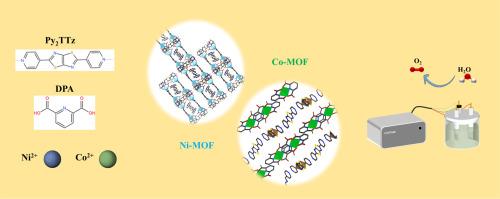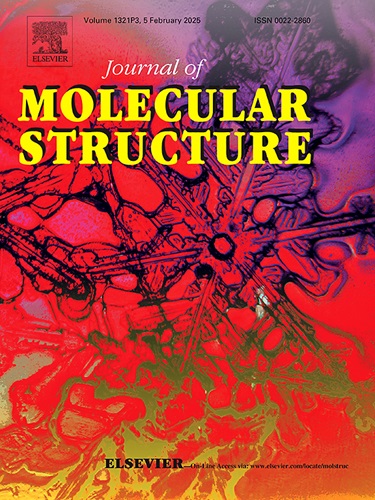Synthesis of Co/Ni-MOFs with mixed ligands and their Oxygen Evolution Reaction (OER) performance
IF 4
2区 化学
Q2 CHEMISTRY, PHYSICAL
引用次数: 0
Abstract
Two new transition metal–organic framework (MOF) complexes, Co-MOF (C28H17CoN6O9S2) and Ni-MOF (C28H6NNi8O2S0.06), were synthesized using a hydrothermal method. Upon characterization and analysis, Co-MOF and Ni-MOF showed similar structures, in which Co2+ or Ni2+ coordinated with two pyridine-2,6-dicarboxylic acid ligands to form octahedral geometric configurations, which in turn formed one-dimensional layered structure, while Py2TTz ligands existed between these layers to enlarge the pore size of MOFs. Co-MOF showed superior performance than Ni-MOF in the OER process, with a low overpotential (227 mV) and Tafel slope (51.4 mV dec‑1) at 10 mA cm-2 current density. This work provided new insight into designing transition MOFs for electrocatalytic water splitting.

具有混合配体的 Co/Ni-MOFs 的合成及其氧进化反应 (OER) 性能
采用水热法合成了两种新的过渡金属有机框架(MOF)配合物 Co-MOF(C28H17CoN6O9S2)和 Ni-MOF (C28H6NNi8O2S0.06)。经表征和分析,Co-MOF 和 Ni-MOF 显示出相似的结构,其中 Co2+ 或 Ni2+ 与两个吡啶-2,6-二羧酸配体配位形成八面体几何构型,进而形成一维层状结构,而 Py2TTz 配体则存在于这些层之间,以扩大 MOF 的孔径。在 10 mA cm-2 电流密度下,Co-MOF 的过电位(227 mV)和 Tafel 斜率(51.4 mV dec-1)均较低,在 OER 过程中表现出比 Ni-MOF 更优越的性能。这项工作为设计用于电催化水分离的过渡 MOF 提供了新的见解。
本文章由计算机程序翻译,如有差异,请以英文原文为准。
求助全文
约1分钟内获得全文
求助全文
来源期刊

Journal of Molecular Structure
化学-物理化学
CiteScore
7.10
自引率
15.80%
发文量
2384
审稿时长
45 days
期刊介绍:
The Journal of Molecular Structure is dedicated to the publication of full-length articles and review papers, providing important new structural information on all types of chemical species including:
• Stable and unstable molecules in all types of environments (vapour, molecular beam, liquid, solution, liquid crystal, solid state, matrix-isolated, surface-absorbed etc.)
• Chemical intermediates
• Molecules in excited states
• Biological molecules
• Polymers.
The methods used may include any combination of spectroscopic and non-spectroscopic techniques, for example:
• Infrared spectroscopy (mid, far, near)
• Raman spectroscopy and non-linear Raman methods (CARS, etc.)
• Electronic absorption spectroscopy
• Optical rotatory dispersion and circular dichroism
• Fluorescence and phosphorescence techniques
• Electron spectroscopies (PES, XPS), EXAFS, etc.
• Microwave spectroscopy
• Electron diffraction
• NMR and ESR spectroscopies
• Mössbauer spectroscopy
• X-ray crystallography
• Charge Density Analyses
• Computational Studies (supplementing experimental methods)
We encourage publications combining theoretical and experimental approaches. The structural insights gained by the studies should be correlated with the properties, activity and/ or reactivity of the molecule under investigation and the relevance of this molecule and its implications should be discussed.
 求助内容:
求助内容: 应助结果提醒方式:
应助结果提醒方式:


